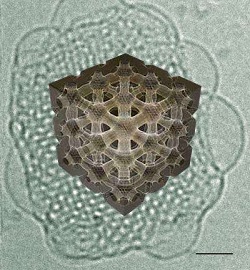 |
| 3-D reconstruction of cubosomal capsule--Courtesy of EPFL |
Swiss researchers have studied the three-dimensional structure of "cubosomes," which are naturally occurring collections of cube-shaped fat molecules; and with new knowledge, they have inched closer to using the capsules to deliver drugs and nutrients.
Many drug carriers are spherical by nature because of the way they assemble as bubbles of lipids called liposomes. Cubosomes, on the other hand, offer intricate internal channels with a much higher surface area than spherical liposomes, making them ideal for drug delivery. More surface area allows for a higher degree of control when releasing the drug at its target.
But because cubosomes also form spontaneously--they are structures found on the cell membrane and can be recreated using fats and detergent--they need to be studied internally to determine their worth. The scientists at the Swiss Federal Institute of Technology in Lausanne (EPFL) created computer simulations using cryo-electron tomography, keeping the cubosome at extremely low temperatures and photographing it at different angles.
This way, the researchers could study the vast intricacies of the inside of the cubosome and its many channels that could potentially be used for delivery.
"With this approach we can now forge a new understanding of the structure of the cubosomes' interior," EPFL's Davide Demurtas said in a statement.
The scientists published their findings in the journal Nature Communications, writing: "These results advance our understanding of these systems and pave the way to a rational understanding of biological phenomena associated to reversed bicontinuous cubic phases and molecular transport properties in these fascinating structured colloids."
- here's the Phys.org story
- and here's the Nature Communications article